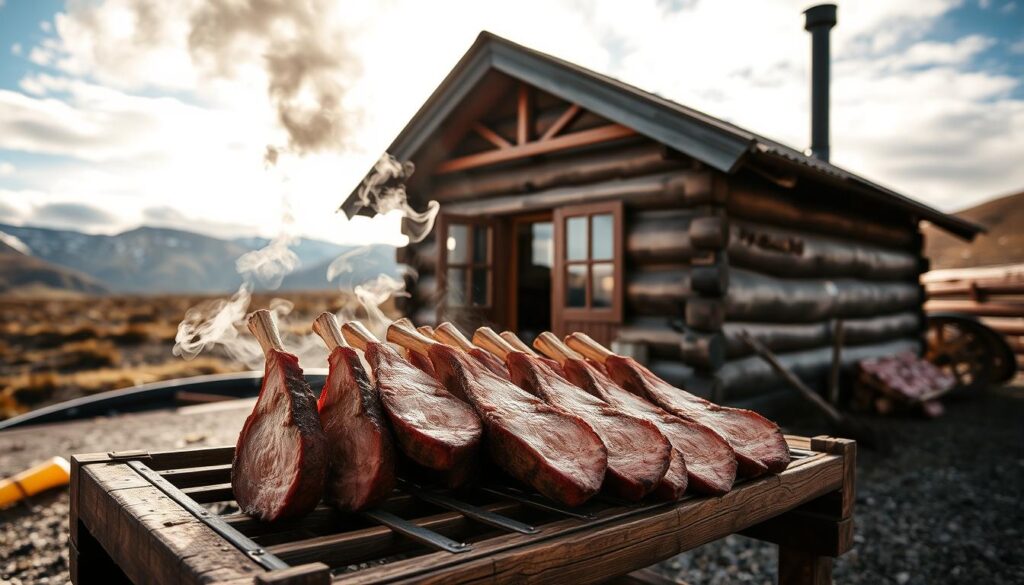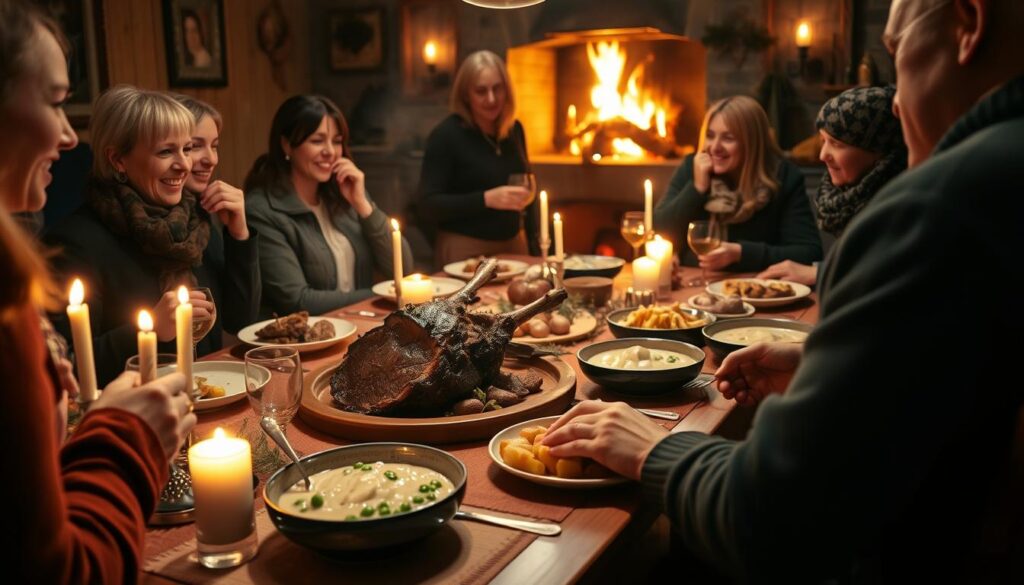Have you ever wondered how a dish can capture the essence of a nation’s history and culture? Hangikjöt, a traditional Icelandic smoked lamb dish, is more than just a meal—it’s a testament to Iceland’s resourcefulness and culinary ingenuity. Originating from the limited resources of a rugged landscape, Icelandic cuisine developed unique techniques that have stood the test of time.
Centuries ago, Icelanders relied on sheep for both food and clothing, using every part of the animal to ensure nothing went to waste. Smoking lamb over sheep dung was a clever preservation method, born out of necessity when trees were scarce. This traditional technique not only flavored the meat but also allowed it to be stored for long periods, making it a staple during harsh winters.
Today, Hangikjöt remains a beloved dish, often served during Christmas. It’s typically paired with creamy béchamel sauce, boiled potatoes, and canned peas, creating a hearty and comforting meal. Whether enjoyed as a festive feast or a satisfying lunch on rye bread, this dish continues to connect Icelanders with their heritage.
Key Takeaways
- Hangikjöt is a traditional Icelandic smoked lamb dish with deep cultural roots.
- The dish originated from Iceland’s limited resources and innovative preservation techniques.
- Smoking lamb over sheep dung was a historical method to preserve meat.
- Hangikjöt is often served with potatoes, béchamel sauce, and peas, especially during Christmas.
- It remains a popular choice for both festive meals and everyday lunches.
The History and Origins of Hangikjöt – Traditional Icelandic Smoked Lamb
Discover how this beloved dish reflects Iceland’s resilience and creativity. Originating centuries ago, Hangikjöt emerged as a vital food source during harsh winters.
Ancient Smoking Techniques and the Role of Sheep Dung
Early settlers faced a challenge with scarce birch and willow trees, leading them to use sheep dung for smoking. This method not only preserved meat but also added a unique flavor.

Preservation Methods and Seasonal Traditions
The smoking process, combined with salting, allowed for long-term storage. This technique became a cornerstone of Icelandic cuisine, especially during winter when fresh food was scarce.
| Method | Steps | Purpose |
|---|---|---|
| Dry-Salting | Coating meat with salt | Draws moisture, prevents spoilage |
| Brining | Soaking in saltwater | Enhances flavor, tenderizes meat |
| Smoking | Exposure to controlled smoke | Preserves, adds flavor |
Hangikjöt’s preparation is a testament to Iceland’s adaptability, transforming necessity into a cherished tradition.
Cultural Significance and Festive Traditions in Iceland
Food has always been a cornerstone of Icelandic culture, and few dishes embody this heritage as deeply as Hangikjöt. This traditional dish is woven into the fabric of Icelandic identity, particularly during the festive season.
Hangikjöt as a Christmas Staple
Christmas in Iceland is synonymous with Hangikjöt. The dish is often served as the centerpiece of the holiday meal, accompanied by creamy béchamel sauce, boiled potatoes, and peas. This tradition reflects the Icelandic spirit of resilience and resourcefulness, as the dish itself was born out of necessity centuries ago.
Community, Family, and the Icelandic Way of Life
Hangikjöt is more than just a meal; it’s a symbol of community and family bonds. The preparation process, often a communal effort, brings people together. A heartwarming story from Icelandic folklore tells of an escaped convict who sought refuge with a farmer and his daughter during Christmas. They welcomed him with a generous meal of Hangikjöt, showcasing the Icelandic values of compassion and forgiveness.
| Cultural Aspect | Significance |
|---|---|
| Community Bonding | Preparation is a collective effort, strengthening family ties. |
| Festive Tradition | Central dish during Christmas, symbolizing resilience and heritage. |
| Forgiveness & Compassion | Illustrated by the story of the escaped convict being welcomed with Hangikjöt. |

Hangikjöt serves as a reminder of Iceland’s harsh winters and the ingenuity that allowed its people to thrive. It’s a dish that transcends mere sustenance, embodying the warmth and unity of Icelandic society.
Modern Recipes and Regional Flavors
Today, chefs and home cooks are breathing new life into this classic dish, blending innovative techniques with its rich heritage. The result? A fresh, contemporary take that appeals to both locals and visitors.
Contemporary Adaptations of the Classic Dish
Modern recipes often feature tender, thinly sliced lamb served with a light béchamel sauce. Some chefs add a twist by infusing the sauce with local herbs or spices, enhancing the dish’s depth without losing its traditional charm.
The Role of Potatoes, Béchamel, and Peas in Present-Day Versions
These sides are more than just accompaniments; they elevate the meal. Creamy béchamel adds richness, while potatoes and peas provide comforting familiarity. Together, they create a balanced, satisfying dish perfect for any time of day.
Local Dining Experiences and Restaurant Highlights
Reykjavik’s culinary scene offers exciting interpretations of this beloved dish. Restaurants like Saegreifinn and Laundromat Café showcase sustainable, locally sourced ingredients, blending tradition with modern flavors.
| Restaurant | Specialty | Highlight |
|---|---|---|
| Saegreifinn | Seafood & Traditional Dishes | Famous for its lobster soup and cozy atmosphere. |
| Laundromat Café | Fusion Cuisine | Offers a unique blend of Icelandic and international flavors. |
These modern adaptations ensure the dish remains vibrant, connecting past and present while welcoming new tastes and traditions.
Conclusion
As we explore the rich tapestry of Icelandic cuisine, one dish stands out for its enduring legacy and cultural significance. This iconic dish, deeply rooted in history, continues to captivate both locals and visitors with its unique flavor and cultural importance.
The historical smoking process, using sheep dung, gave the meat its distinctive taste, making it a staple during harsh winters. Today, it’s a centerpiece of festive meals, especially during Christmas, served with creamy béchamel sauce, potatoes, and peas.
Modern chefs have reimagined this classic, blending tradition with contemporary flavors. Restaurants like Saegreifinn and Laundromat Café offer fresh takes, ensuring its appeal endures for new generations.
More than just a meal, this dish embodies Iceland’s resilience and communal spirit. Whether enjoyed at home or in a local restaurant, it invites everyone to experience the warmth of Icelandic heritage. So, take a moment to savor this timeless dish and let its story become part of your own culinary journey.